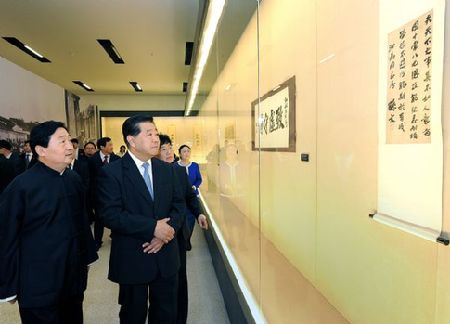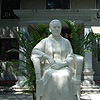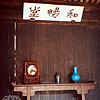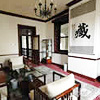On October 10, 1911, the Wuchang Uprising broke out. With one province after another declaring independence from the Qing Dynasty government. As a result, the rule of the Qing Dynasty collapsed, marking an end to the feudal autocratic monarchy of more than 2,000 years and founding the first republic in Chinese history.
To pay tribute to the 100th anniversary of the Chinese Revolution of 1911, with the guidance of Chinese Ministry of Culture, our team designed the photo album which is named "A Century of Change". Through the feature, we will share our insight from our hard work with the readers too.
China's Top Political Advisor Visits Exhibition of Calligraphy
|
 |
BEIJING, Sept. 14 (Xinhua) -- China's top political advisor, Jia Qinglin, visited on Wednesday an exhibition showcasing the calligraphy and scripts of key figures in the 1911 Revolution.
Jia, chairman of the National Committee of the Chinese People's Political Consultative Conference, visited the exhibition in the National Museum in Beijing.
|
 |
The exhibition, from Tuesday to October 20, features 120 valuable and rare pieces of calligraphy, scripts and letters written by leaders and key figures in the 1911 Revolution, including Sun Yat-sen, Huang Xing, Cai Yuanpei and Song Jiaoren.
This year marks the centennial of the 1911 Revolution which overthrew the Qing Dynasty and ended China's 2,000 years of imperial rule.
Source from xinhuanet.com
Editor: Shi Liwei
1、The Preparation of the Revolution
In November 1894, Sun Yat-sen setted up the Xingzhonghui in Honolulu. The next year in February, Sun built the headquarters of Xingzhonghui in Hongkong, and put forward the first guiding principle of the China democratic revolution.
2、The Uprising of the Revolution
The incompetent and corrupt rule of the Qing Dynasty caused extreme anger in Chinese people, finally, In June 1911, the Railway Protection Movement in Sichuan became the trigger of the Chinese Revolution of 1911.
3、The Success and Failure
December 1st, the Qing government signed the armistice with the revolutionary army, and the battle was stopped for three days. This truce is a key turning point that marks the revolution army changed the view from armed struggle to the politics of compromise.
4、Historic
The Chinese Revolution of 1911 is a great bourgeois-democratic revolution, which has far-reaching historic in modern Chinese history.




